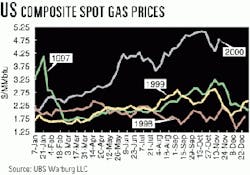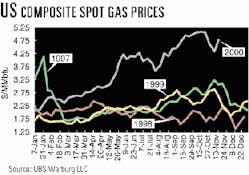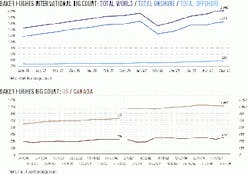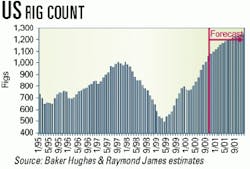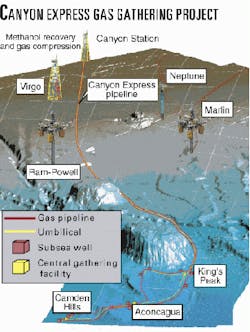Market Movement
Cool temperatures boost gas prices
Now energy prices are being whipsawed by the weather.
Unseasonably warm weather had taken the wind out of the sails of high gas prices earlier this month, but that trend was abruptly reversed in the past week or so.
Early in the month, temperatures rose across the US to higher than normal levels. With the heating season getting off to a relatively weak start and the onset of some nuclear power capacity coming back on line in late October, spot prices fell about 50-70¢ below October's levels (see chart). A spurt of cold weather in early November pushed gas prices back up to the mid-$5s again.
That was followed by a brief plunge to well below $5 before the onset of cold weather at midmonth pushed NYMEX gas futures to a record $6.27/Mcf. Prices eased a bit back to the mid-$5s until last week's cold snap rocketed natural gas futures back to a new high-albeit briefly-of almost $6.40 before settling back to close at $6.25 Nov. 20. The price surge came as a result of the first withdrawal from natural gas storage this year, compared with an injection into storage for the same period a year ago.
Weather forecasters late last week were anticipating a return to warmer weather across the US following the Thanksgiving holiday. However, the overall consensus forecast for the main consuming regions of the US, the Midwest and Northeast, calls for a return to normal winter weather during December-which means colder than the US has seen in the past three winters.
While natural gas prices rollercoaster in response to the whims of Mother Nature, it is important to remember that these seasonal shifts represent volatility at a level near $6/Mcf. This points to the continuing strength of the underlying market fundamentals for natural gas in North America. The lackluster onset of the heating season only meant the industry had another chance to bring natural gas inventories up to a level of about 2.7-2.8 tcf-still well below the level desirable for ending the heating season with a comfortable remaining cushion next March ahead of the next cooling season.
With expectations of normal winter temperatures, the US is likely to end the heating season at well below the desired level of 1 tcf-perhaps even half that level. Even another warm winter won't bring storage levels to much more than 1 tcf, which is where the market ended last winter. That sets the stage for gas prices remaining strong throughout 2001, probably $4-5/Mcf.
But a real sustained blast of cold weather persisting for several weeks this winter will probably see spot prices rocket into the double digits-perhaps briefly as high as $20-30/Mcf, some analysts are warning.
Drilling rates rising
As for continuing concerns over gas supplies, particularly the level of wellhead deliverability, it is important to note that this is a time of year that typically Canadian rig activity takes a hit because of sloppy weather conditions hindering rig movement. Nevertheless, the Canadian rig count rose to 404 in early November, 8 rigs higher than the last week of October and 30 rigs more than a year ago at this time.
US rig activity slipped a bit early in November, but the US tally remains well above 1,000. For both areas, the bulk of this increased activity is still focused on natural gas. However, the gas wells getting drilled in both countries get depleted much more rapidly than in the past, so it is going to take a lot more wells to provide a cushion for wellhead deliverability than had been the case even a decade ago.
Higher US drilling rates have begun to boost the country's natural gas supply, EIA says, hiking its estimate for 2001 production growth to about 350 bcf, up from 240 bcf in previous outlooks. But it says this winter's gas prices will still be about 90% higher than last winter.
In the fourth quarter this year, previously falling demand for oil-fired generation is expected to turn around relative to gas-fired generation, as the price differential between the two fuels in the electricity generating sector shifts to favor oil. The favorable oil-to-gas price differential is expected to continue through 2001.
Heating oil concerns
The jitters over heating oil supplies in the US this winter aren't going away, either.
US heating oil inventories fell much farther than expected the week ended Nov. 10 and stubbornly persist at a level more than 30% below a year ago.
Stocks of heating oil in the US plunged by 665,000 bbl to 46.8 million bbl during the week ended Nov. 10, API reported.
That report sent heating oil prices to a close of $1.0788/gal by Nov. 17 for the NYMEX December contract. The subsequent cold snap early last week then jumped that contract to $1.0962, the highest price seen for heating oil since the Oct. 12, 1979, record of $1.11/gal.
Heating oil in the US now costs about 60% more than it did a year ago, but DOE estimates that heating oil bills will be only 25% higher this winter.
OPEC cuts ahead despite high crude oil prices?
Despite NYMEX crude futures contracts persisting above $35/bbl last week, partly in response to the colder weather, OPEC members continued to talk up the prospect of production cuts early next year because of a saturated world oil market. Such talk has elicited a flurry of criticism from Western leaders concerned about the effects of high oil prices on their nations' economies (see related story, p. 24).
At the end of a 3-day international energy conference last week in Riyadh, Saudi Arabia, Alí Rodríguez Araque, Venezuela's energy minister, warned that producers should prepare for an output reduction as early as January, if prices start to decline.
Rodriguez, who becomes the new OPEC secretary general on Jan. 1, said there is already a crude surplus of 1.4 million b/d, about 2% of the total global market. When crude inventories equal 90 days of consumption, he said, "We expect oil prices to drop."
At that same meeting, Abdullah Bin Hamad Al Attiyah, Qatar's energy minister, said he expects oil prices to plummet below $22/bbl in the second quarter of 2001.
Scoreboard
Due to a holiday in the US, data for this week's Industry Scoreboard are not available.
Industry Trends
THE US RIG COUNT HAS AGAIN SURPASSED ANALYSTs' EXPECTATIONS….
For the third time this year, Raymond James is raising its 2000 yearend US rig count forecast to 1,100 from 1,050 and its yearend 2001 forecast to 1,250 from 1,150 (see chart). Raymond James says that even though it anticipated an exceptionally strong demand for rigs, it underestimated the speed at which drilling contractors could find crews and refurbish stacked rigs.
"What we have noticed over the last few months is that contractors have been able to attract crews through slightly higher wages and refurbish rigs faster than we had anticipated. In fact, Naborsellipsemanagement suggested that the company is working as many of its US Lower 48 land rigs as possible but is aiming to refurbish and put an additional 50 rigs into the market by the end of January."
….AND CANADA'S DRILLING CONTRACTORS ARE SCRAMBLING FOR WORKERS.
The Canadian drilling industry has launched a national campaign to attract a minimum of 3,000 workers because of labor shortages and escalating demand for rigs this winter.
The Canadian Association of Oilwell Drilling Contractors says there is an unprecedented and severe shortage of people available to work on rigs.
CAODC Pres. Don Herring said newspaper and radio advertising will be aimed at rural areas in Atlantic Canada and western Canada as E&P companies seek to capitalize on high oil and gas prices.
Herring said the drilling industry is competing for workers in a generally tight labor market with the construction, pipelining, logging, and mining industries. The unemployment rate in Alberta, which accounts for most of Canada's drilling activity, is at 4.7% compared with a national average of 6.9%.
The drilling association predicts an average 560 rigs will be operating in Canada in the first quarter of next year. It said that there are about 11,000 drilling workers in Canada and that the industry will need at least 14,000 to meet projected demand.
Individual companies are increasing wages and offering retention bonuses to keep experienced staff.
CAODC said workers can expect to earn a minimum of $16/hr (Can.), plus overtime, and accommodation allowances of up to $95/day.
The campaign was launched as concerns over short gas supply and impending cold weather in US markets boosted spot prices for gas (see Market Movement, p. 5).
Gas storage in the US is low. Western Canada storage is at a 5-year low of 221 bcf, 34 bcf below levels at the same time a year ago.
Government Developments
The US Department of Commerce has appealed a court's order that it reconsider a case alleging four nations "dumped" crude on the US market in 1998-99.
The US Court of International Trade, New York City, ruled Commerce must reconsider the petition of Save Domestic Oil, which the department rejected in August 1999 (OGJ, Oct. 16, 2000, p. 49) on the grounds that it had insufficient industry support.
SDO, representing US independent oil producers, had claimed that Saudi Arabia, Venezuela, Mexico, and Iraq had sold crude at unfair prices in late 1998 and early 1999.
Earlier this month, Commerce asked the District of Columbia US Circuit Court of Appeals to issue a stay of the order, pending a formal appeal.
Meanwhile, the Petroleum Industry Research Foundation (PIRINC), New York City, warns that the appeal could impact world and US oil markets that "are currently extraordinarily sensitive to any threat of disruption."
PIRINC said market conditions are different from 1998-99, when the petitions were first filed.
"All the market 'safety valves' have virtually disappeared. Stocks are exceptionally low, and spare producing capacity is minimal, with most of what spare exists is concentrated in one country, Saudi Arabia. Refineries have been operating at record levels, and logistics systems are at full capacity.
"Pipelines are full, and shipping is extremely tight, with tanker rates for Persian Gulf crude delivered to the US Gulf Coast up threefold from year-ago levels, from about 95?/bbl to $2.75/bbl."
PIRINC said it is essential for the US government to maintain cooperative relationships with key producers, particularly Saudi Arabia, to facilitate a return to more normal market conditions. It noted that the US is heavily dependent on imports to meet its oil needs and that dependence is almost certain to grow.
MMS HAS PROPOSED A SUPPLEMENTAL ROYALTY RELIEF for marginal leases.
MMS published this month a proposal to allow additional discretionary royalty relief on a case-by-case basis for marginal oil and natural gas leases on the US OCS.
The supplemental proposal, an amendment to MMS's royalty relief regulations published Sept. 14, would allow certain Gulf of Mexico leases at least 200 m deeper and sold after this year to be eligible for additional discretionary royalty suspensions.
MMS said it proposed the rule to encourage the development of marginal leases by allowing producers with marginal leases to seek royalty relief on an individual basis. This would prevent MMS from having to offer blanket relief to other categories of properties at the same level that might not need additional royalty incentives.
The agency said the incentives will help sustain the increase in deepwater exploration and development activity created in part by the Deep Water Royalty Relief Act of 1995.
Quick Takes
PHILLIPS Alaska has begun production at Alpine oil field on Alaska's North Slope.
Phillips says Alpine will reach peak production of 80,000 b/d by yearend. It estimates the field's reserves at 429 million bbl. The field will cost more than $1 billion to develop.
The field is in the Colville River area, 8 miles from the village of Nuiqsut. At the first Alpine drillsite, 30 wells-16 production and 14 injection-have been completed. Another drillsite is planned, as are more than 112 horizontal wells.
Phillips said development of the first site includes the use of miscible injectant generated from the existing gas in the field, creating an EOR project. Phillips Alaska holds 78% of the field, and Anadarko holds 22%.
In other production news, DNO Heather said its recent success with an infill well in Heather field demonstrates that mature fields in the North Sea still have much oil to deliver. DNO doubled production from Heather field to 8,500 b/d by bringing infill well H-61z on stream. The field is east of the Shetland Islands on Block 2/5. The last time Heather produced at that level was in 1993. Production is, however, expected to decline over the next few weeks. H-61z was producing 4,500 b/d of oil with tubing head pressure of 1,700 psi. The well was also producing 650 cfg/bbl produced, allowing operators to suspend gas importation. It was designed to develop untapped oil in fault blocks on the northern edge of the field. "ellipseWell H-61z was sidetracked from a previously suspended well (H-58z) and reached a TD of 15,500 ft.
The Heather reservoir is only 250 ft thick, but the well was steered subhorizontally through three fault blocks and penetrated a total of 2,300 ft of gross reservoir," said Stewart Watson, CEO. DNO took over the field from Unocal earlier this year and extended the expected field life by 10 years or more (OGJ, May 1, 2000, p. 26). Royal Dutch/Shell has decided to revive production at Nang Nuan field on Block B6/27 in the Gulf of Thailand. The field was shut in 3 years ago. Earlier this year, the company began reconsidering the project because of a favorable reassessment of geological data, as well as rising oil prices (OGJ Online, June 21, 2000). Through its local unit Thai Shell E&P, the firm intends to begin work on the Nang Nuan structure in the first quarter. Shell will re-enter Nang Nuan B01, a well that produced 4.25 million bbl of oil over 4 years. Output from B01 was halted in January 1997 because water intrusion damaged the oil reservoir. Shell will also drill an exploration well near Nang Nuan, which is off the Chumphon coast in about 30 m of water. Thai Shell hopes to resume oil production from the re-entered well at 12,000 b/d, the well's former peak, during the third quarter of next year. Thai Shell expects to spend at least $4 million for the revived drilling campaign and several million dollars more on the offshore production facilities. Triton Energy said the Sendje Berge floating production, storage, and offloading vessel arrived in Ceiba field off Equatorial Guinea. The FPSO will produce 52,000 b/d of oil from the field. The Sedco 700 semisubmersible rig is completing Ceiba-1, the last of four wells that will begin to produce oil to the Sendje Berge.
TOPPING DRILLING NEWS THIS WEEK, Norsk Hydro awarded Smedvig a 2-year, $110 million contract for use of Smedvig's West Delta semisubmersible drilling rig.
It also awarded Smedvig a 19-month continuation of an existing contract for use of the West Vanguard rig, setting the contract's end at the end of December 2002. The contract is worth $70 million.
In other drilling news, Noble Drilling acquired the 30% interest in the Ilion semisubmersible rig that it did not already own. It paid $12.8 million for the interest. Noble Drilling recently awarded Friede Goldman Halter a contract to upgrade the Ilion's hull (OGJ Online, Nov. 3, 2000).
ALASKA SOLD 149 TRACTS FOR $10.6 MILLION AT A NORTH SLOPE AREA-WIDE OIL AND GAS LEASE SALE NOV. 15.
The state Department of Natural Resources said bidders filed 158 valid offers, exposing $10.9 million. A consortium of Phillips Alaska, AEC Oil & Gas, and Chevron submitted the sale's high bid, $669,024, for tract 0577. That was $116.15/acre, also the high for the sale.
A partnership of Anadarko and AEC Oil & Gas led the sale, submitting $1,454,668 in high bids for 42 tracts. Phillips, AEC, and Chevron exposed $5,788,396 for 32 tracts. Andadarko offered $382,649 in high bids for 15 tracts, BP Exploration (Alaska) $881,894 for 13 parcels, and AVCG $754,560 for 11 tracts.
In other exploration news, a Westech Energy New Zealand-led exploration group has been joined by Pancontinental Oil & Gas for the redrilling of the Waitaria gas prospect in the onshore East Coast basin of New Zealand's North Island. Pancontinental said it will earn a 7.5% interest in the permit by contributing 10% of the expected $1.37 million cost of the Waitaria 2 well that is due to spud in January. Pancontinental would pay only 7.5% test and completion costs. Waitaria 1 failed to reach the objective mid-Miocene Tunanui sandstone when drilled in 1997 because of mechanical problems through a high-pressure zone. Despite high mud weights, the well recorded background gas levels up to 1%. Ethane and butane readings were consistently above 100 ppm. Waitaria 2 will be drilled next to the Waitaria 1 to 1829 m. The prospect has been delineated by 2D seismic and mapped as a four-way dip closure over 6 sq km. Vertical closure is interpreted to be 700 m, and potential reserves of the prospect are postulated at 360 bcf of gas. Interests in the well will be Westech 27.5%, Pancontinental 7.5%, Orion Exploration 27.5%, Indo-Pacific Energy (NZ) 25%, Sun Resources 7.5%, and Everest Energy 5%. Polish Oil & Gas Co., Poland's national energy firm, will buy 30% of a EuroGas subsidiary and become operator of an oil and gas concession in southeastern Poland. EuroGas holds exploration and development rights to 1,070,000 acres in 10 concessions. EuroGas said geologists have identified 12 exploration targets in the Rymanow-Lesko area near Sanok. The Rymanow-Lesko area is between the Boryslaw oil region of Ukraine and the oil production region of Krosno in Poland. Eurogas said, "The largest of these targets, at a depth of around 2,000 m, could contain oil in place of up to 47 million tonnes (350 million bbl), or an equivalent in gas. If confirmed, it would be one of the biggest oil and gas discoveries in Central Europe." EuroGas and POGC will begin shooting seismic in the region this year and plan a wildcat next year.
Harken Energ will spud the second exploratory well on the Cambulos Association Contract block in the Middle Magdalena Valley, Colombia, in December. Manantial No. 1 will be drilled on the Delta prospect in the southeast corner of the 41,000-acre block. It will test the Hoyon formation. Harken holds 100% of the well.
BP plans gas-fired cogeneration power plants at its Texas City and Chocolate Bayou, Tex., processing complexes.
Negotiations are under way with Cinergy and Power Solutions to undertake the two power plants, which will produce steam as well as electricity for the two complexes.
The facilities are part of a plan to reduce nitrogen oxide emissions from those plants. BP Global Power, the power development arm of BP Gas & Power, will be among those investing in the project.
The equipment will allow BP to shut older, less efficient power units, resulting in NOx emission reductions of about 50% from the Texas City refinery and 34% from the Chocolate Bayou petrochemicals plant. Carbon dioxide emissions also will be reduced by 727,000 tonnes/year.
After the existing and new power units are combined, they will be able to produce 805 Mw of electricity and 3.5 million lb/hr of steam. The project will help the Texas Natural Resources Conservation Commission achieve its goal of reducing emissions by 90% from industrial plants in the area.
BP also is working with the city of Houston to provide an ultralow-sulfur diesel which, when used in conjunction with after-treatment technologies, reduces NOx, sulfur, and particulate emissions.
TOTALFINAELF has started working on what may be the deepest pipeline in the gulf of mexico.
TotalFinaElf has begun work on its Canyon Express natural gas gathering system, the deepest pipeline yet in the Gulf of Mexico.
The 55-mile line will enable the development of three gas fields in 7,000 ft of water-Aconcagua, King's Peak, and Camden Hills-in the Mississippi Canyon area 120 miles southeast of New Orleans (see map).
The dual 12-in. gathering line, with a capacity of 500 MMcfd, is due for completion in summer 2002. TotalFinaElf affiliate Elf Exploration is operator of Aconcagua with a 50% interest. Partners are Mariner Energy with 25% and Pioneer Natural Resources with 25%. BP owns and operates King's Peak. Marathon Oil operates Camden Hills with a 50.03% share. Partners are Total E&P with 16.67% and Pioneer with 33.3%. Elf Exploration will operate the Canyon Express system, which will be owned 45% by the Aconcagua owners, 35% by BP, and 20% by the Camden Hills owners.
The line will move gas to a platform, Canyon Station, which will be in- stalled 55 miles north of Camden Hills on Block 261 in the East Main Pass area south of Mo- bile Bay. A Williams unit will own and operate the platform. The processing platform will connect with three pipelines that move gas to shore. Platform construction is slated to begin next summer and be completed in second quarter 2002.
Elsewhere on the pipeline front, Duke Energy and Williams have agreed to purchase Coastal's 100% interest in the Gulfstream gas pipeline. They will develop the Gulfstream line rather than the two firms' competing Buccaneer pipeline. Gulfstream would move gas 744 miles across the Gulf of Mexico from Alabama to the eastern coast of Florida. The $1.6 billion Gulfstream pipeline, which will have 1.1 bcfd of capacity, should come online in June 2002. Buccaneer would extend 420 miles across the Gulf of Mexico from Alabama to western Florida. "We have recognized for some time that the market will support only one new pipeline into the state of Florida," said Cuba Wadlington Jr., president and CEO of Williams's gas pipeline group. Gas demand in Florida is expected to soar, prompted in part by need for more electricity in the state. Duke Energy said electricity generation growth there is expected to hit 10,000 Mw by 2007. Conoco and Russian firms OAO Lukoil and OAO Arkhangelskgeoldobycha plan to build a pipeline to supply Russia's Nenetski Autonomous Okrug. The proposed system is expected to move up to 7.5 million tonnes/year of oil from the Northern Territories fields. It also would allow for additional production of crude from other fields in Timan Pechora Province. The project includes construction of land and marine pipelines. A stationary ice-resistant oil terminal also will be built. Oil will be shipped in 20,000-120,000 dwt icebreaking tankers. Lukoil, Arkhangelsk- geoldobycha, and Conoco are partners in the Northern Territories project, which includes 1.2 million acres in the Timan Pechora region above the Arctic Circle. Lukoil will hold a 60% interest in the Northern Territories project and Conoco the remaining 40% (OGJ Online, June 6, 2000).
